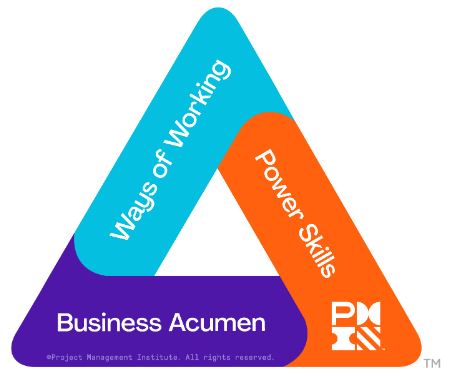
PMI Talent Triangle: Business Acumen (Strategic and Business Management)
Welcome to the PMO Strategies Podcast + Blog, where PMO leaders become IMPACT Drivers! Today you will find out how to be more clear and direct in your communication style, last week was step 6, the final step in the IMPACT PMO Mindset. This week, we are covering the “now what?” The, “what do I do once I get it? Once I have transformed my mindset, once I am thinking differently about my PMO and my role and the role of project management and the best ways to drive IMPACT in my organization. Now what do I do?” What does the plan after shifting your mindset and transforming the mindset of others look like? How do we go from knowing we need to make some shifts in how our PMO is operating and making the shifts in how it’s functioning today? Where might we want to consider improving our IMPACT to the organization overall? On the other hand, if you’re just getting started, how do you make sure that you’re starting off right? That’s what we’re covering today. If you haven’t listened to episode 000, the Introductory episode or 001, The PMO Reset, 002 Instill Focus, 003 Measure Outcomes, 004 Perform Relentlessly, 005 Adapt to Thrive, 006 Communicate with Purpose, 0r 007 Transform Mindset – then I highly recommended you go back and listen or read those from the first step through the series of six steps. My IMPACT PMO Leader mindset shifts are critical for PMO leaders. Working through the steps means that you have your oxygen mask securely fastened BEFORE helping others. If you went through the mindset series via podcast or blog, you’re probably brimming with many great ideas that you are excited to implement. Especially if you downloaded all of those worksheets that went with each of those episodes, you’ve already started taking notes and you’ve got your ideas. For this episode, we will look at a few different areas that you might want to consider when you’re thinking about putting some of your new ideas into place. I put together a little cheat sheet for you of all of the steps that I’m going to go through today so that you’ve got something to write down, your thoughts, your ideas, and your action plan to make sure you actually take action on the new ideas that you have on the areas of opportunity that you’re seeing. You can download cheat sheet of action steps below.
Moving from Knowing to Doing
Ideas are a fantastic starting point, but now the job is to put those ideas into a plan and take action. There’s a fantastic professional speaker that I have been honored and privileged to get to know as a part of the work I’ve been doing on my own professional speaking development career. I have worked in a program called Heroic Public Speaking, which is a fantastic program to grow your professional speaking skills. I refer to a lot of my lessons that I’ve learned through those programs in future episodes and this episode is no exception. One of the professional speakers and educators that we spent time with was a gentleman by the name of Ron Tite, he has a new book coming out called, Think Do Say. I’ve had the privilege of learning some of his teachings in this Think Do Say model in training that he’s offered us through the Heroic Public Speaking programs. I’m going to borrow from Ron’s Think Do Say model as I help you with what you can do when you’re putting your action plan in place for the PMO. Remember, this is how you can get your PMO to be more IMPACTt-focused and IMPACT-driven.
Think
If you take the Think Do Say framework, in the context of what we need to do as PMO leaders, first we need to think differently, as you did in the IMPACT PMO Leader Mindset Series. This is critical before we can take any actions or take the right actions or start bringing others with us through the change process, we have to shift our mindsets ourselves. Episodes 001-007, the IMPACT PMO Leader Mindset Series was all about Think, thinking differently. Now that we’ve got our different perspective about the PMO or our enhanced or highlighted or more IMPACT-focused mindset for the PMO. We’ve got think covered, but if you haven’t listened to those prior episodes, let me just go through what those mindset shifts are really quickly for you. It’s called the IMPACT PMO Leader Mindset Series because it’s all about the word IMPACT. You will hear me talk about IMPACT all the time because I believe that we’ve got to shift to be more outcome-focused, instead of only focusing on the outputs that we are creating as a part of our PMO. It’s all about getting to that return on investment or ROI for our projects and for every bit of time and energy we spend.
The first letter in IMPACT PMO Leader Mindset is I, and that is for Instilling focus. We have to make sure that we are focusing our energy on the right solutions. And to do that, we’ve got to be solving business problems. We must ask “why?” Why is the PMO there in the first place? Why are we creating all of these templates, tools, process? Why are we creating additional resources? Why are we putting certain processes in place? We must ask why and get laser-focused on the deliverables as it pertains to getting to IMPACT everything we create. Everything we do, everything we’re talking about is getting to that why. That was that first layer, that Instilling focus step in the IMPACT series.
Next, we go to the letter M which is for Measure outcomes. I am a firm believer that we must not get stuck in thinking that EVM (earned value management) is the solution to all of our problems. Often we start talking about measuring progress and performance and forget to measure IMPACT or the outcomes that we’re achieving. I’m a strong believer whether it’s in measuring the value the PMOs bringing to the table or projects that we are responsible for overseeing or supporting, that we cannot stop by saying we’re busy. We can not stop by saying we’re making progress. We can not stop by saying it was on time, it was under budget or on budget. That’s not the only measures of success. We’ve got to make sure that we also go back and look at if we are actually achieving the business outcomes we intended. Are we achieving that return on investment? That’s what measuring is all about.
The third letter in this series is P for Perform relentlessly. Not just get it done, but perform relentlessly, driving a delivery focus mindset. Talking about IMPACT to everyone, making sure everyone is staying focused on the outcomes, keeping our commitments, minimizing friction by streamlining templates, tools and processes, and not getting caught up in that misbelief that if we create more, we’re showing value. Often the real value comes from creating less so we’ve got to right-size our governance and right size how we are engaging so that we are continuing to perform relentlessly all the time. That’s how we build our credibility in the organization and ultimately make that IMPACT with the PMO that we are trying to make. After P, we go to A for Adapt to thrive. Adapt to thrive means we’re looking at adjusting our management style, not just based on different personalities, but on how familiar people are with the change. We’re getting business-driven and business-focused with business knowledge and understanding business acumen. We’re looking at stakeholders from the perspective of do they love what we’re doing and are they supporting us? Do they hate it? Either is fine because at least we know who they are. Do they just don’t care? When we are adapting we are also looking for ways to be more business-focused and making sure that our processes and our solutions and the way we’re reprioritizing and the way we’re engaging is all about being adaptive and iterative and nimble. This allows us to respond to change quickly.
The C in IMPACT is all about Communicating with purpose. Communicating with purpose is making sure that we don’t talk project management, speak at our stakeholders. When their eyes start glazing over, it’s because we’re speaking our language, not theirs and we lose them. Losing the stakeholders means we lose credibility, we lose engagement, we lose support. They don’t know how to work with us. We’ve got to make sure that we’re avoiding information indigestion and not putting so much information in front of our stakeholders that they can’t even help us make the decisions we need made so we can keep things moving forward. We look at tying all the things we’re doing as a PMO to the IMPACT it’s having on the organization. We’re connecting the outcomes of projects to the support we provided. We’re connecting the services and the capabilities to the outcomes and the impact they’ll have on the organization and we’re doing it in a way that’s driving actions and decisions and getting just the right amount of information in front of our stakeholders and then stop talking, stop providing data, and stop pushing it so hard.
The last step in this IMPACT PMO Leader Mindset series was T, Transform mindset. Transform mindset means we have to think differently ourselves about our role and take on some new roles that the future PMO leaders are going to have as just a core part of their competencies. This is critical before we can start shifting the mindset of others. Meaning, we need to be entrepreneurial and embrace an entrepreneurial mindset and a way of operating. Give people plenty of room to look at how might we solve this problem as opposed to assuming that we’ve got just one way to do things and that’s the only way we’re going to get things done. That’s not the way the new world is operating. We’ve got to be nimble and quick and agile and flexible, and that means we’ve got to look for creative ways to solve problems. And finally, we talked about new roles that we’re going to be taking on. We talked about becoming the strategy navigator. We talked about the fiduciary responsibility we have as a manager of organizational investments, a.k.a. projects. We talked about the role of trusted advisor, and you can only become a trusted advisor if you’re performing relentlessly and building that credibility. Becoming the trusted advisor comes if you’re communicating with purpose and speaking their language if you’re adapting to thrive so that they know they can come to you when things are shifting, and that you’re going to respond with. Trusted advisor status happens when we’re measuring outcomes, not just outputs, so that we’re actually helping the organization achieve their strategic goals, not just showing that we’ve got a lot of people that are really, really busy. And of course, it’s all built on a foundation of having that instilled focus on why, why we’re doing what we’re doing and why the PMO is there, why the projects are there, and keeping everyone laser-focused on business outcomes from the start. If we are doing all of those things, then we are accomplishing the Think in the Think Do Say model. We are thinking about our role as a PMO differently.
Do
Now we can put our plans together, which is the Do, and then Say is all about how we communicate that, how we tell the story, share the message of IMPACT and shift the mindsets of others. Now what do we do with all of that? What do we do in the do of think? We’ve got to put together a plan that says, okay, now that my mindset has shifted and now that I’m thinking differently, what do I need to do to incorporate my new mindsets and the way I believe? What does engaging as an organization, as a PMO to serve the broader organization and community look like? Now we can put our plans together, which is the Do. For our purposes here today, I’m going to make the assumption that all of you IMPACT Drivers listening know how to put together a plan, you know a thing or two about putting together a work breakdown structure, you know a thing or two about writing down the outcome we need to achieve and the steps we’re going to take to get there. With that assumption, I want to focus on some things to keep in mind as you’re putting together your action plan so that you stay sane when you’re putting the plan together and when you start implementing it. As you look back and reflect on the worksheets you filled out for all of the six IMPACT PMO Leader Mindsets, all of these great ideas you have, I know that you’re probably feeling a little bit overwhelmed. You probably are thinking there are so many places that we need to make change. You are wondering where you should start. Here it is.
Tips to Making the Shift to an IMPACT PMO
Start small. As you’re putting together your work breakdown structure, you’re collecting all of those ideas from the different worksheets and looking at all of the places you could have an IMPACT on the organization, just pick one. How do you pick one? You need to do some prioritization work. Start small and that means that we need to prioritize all of the work that we potentially could do and look for a key opportunity where you can make a big shift quickly. Now, this isn’t about a quick win and you just do it and move forward. This is about finding where you have seen pain and which of these pains presents an opportunity that is in really clear alignment with our why. If you don’t have that, back up and get clear on your why for your PMO. What business problem is it solving? What opportunities are being presented that can help move the organization forward? Get clear on that. If your why is not clear, that is your pick one, your start small. That is the first thing you do is get crystal clear on that. Why? We’ll come back to a little bit more about that in a moment, but keep in mind what I often say, don’t boil the ocean when you can just put one pot on the stove at a time. And what that means is when we’re thinking about starting small, if we want to be effective, if we want to make an IMPACT, narrow the scope to be something that is doable, narrow the scope that doesn’t require you to get 450 people involved in order to make any progress. Find something reasonable, doable and achievable, and then start making that shift first and then move on to the next thing. Make it iterative. You want to make sure that whatever you’re going to take on it, because you’re starting small, you do one thing, you give it a little while to see if it’s working. Then you come back and do the second thing. Now, this very closely follows my very successful framework in my IMPACT Engine PMO training course. We have a specific framework where we have 90-day cycles or 90-day sprints. Even when we will release new capabilities, new services to the organization, and then we let that simmer for a little while. We let that work, we see that it’s happening, we see the progress is being made, we measure that we actually achieved the outcomes intended with that new service or capability. Then we start the next thing. So my second tip is to make it iterative so that you can keep it small and focused and allow both the opportunity for value to be achieved faster and for you to allow time to see that one of the changes you’re making is actually working. Do this and make sure it is moving the needle in the direction that it needs to be moved before you take on the next thing. Don’t feel like you have to take on everything at once and that means that you must go through a prioritization exercise. Take all of that homework you did when you were thinking about the IMPACT PMO Leader Mindset Series and start to organize that based on where you can provide value quickly and then do that one thing first. Then making it iterative is about doing it in iterations and making sure that you allow a cycle to make a change, let it stick. See it’s providing value measure return on your investment of time and energy and resources to put that thing in place. Make sure it had the intended outcomes and then move on to the next thing. And if it’s not, you need to evaluate if you can do something a little differently to tweak it make it work or does it need to be scrapped altogether? This is a good time to point out not to be afraid to toss out an idea or toss out an initiative, service, or capability if it’s not working. But you only know that if you take the time to do that assessment first before you start moving on to the next iteration or the next capability. What happens often is that people will just implement and they’ll do, do, do without any reflection to see if anything worked. Then you’ll start delivering a service over here and then another one in a different department and again and again and again, and you’re throwing up all these new services without actually taking the time to pause, evaluate, and reflect, did this service actually achieve the intended outcomes? This is the very same guidance we must give to our project teams, stakeholders, and sponsors to make sure their project is actually achieving the intended outcomes. We need to do the same thing here with any services or capabilities we’re creating as a PMO. Did it actually do what it was supposed to do? And if it didn’t, how do we get it so that it does or scrap it and move on to a higher priority area?
Don’t over commit. I know that I’ve mentioned this to you before, but I want to say it again because it’s so important. Often, especially if you’re new in your role in the organization, you’ve changed organizations, or as your first time building a PMO. I’ve been there, you’ve been given this great opportunity, and you want to just say yes to everyone because you want to build credibility. Stop trying to please everyone. I’ve been there, I wanted to be a people pleaser. I wanted people to look to us as a PMO and say the PMO has got our back. The PMO is doing what needs to get done. The problem with that is if we say yes to everyone, then we’re going to disappoint some of them. We will achieve our goals in some areas and we won’t in other areas. Remember one pot on the stove at a time, it’s super important that you pick where you’re going to focus your energy and don’t over commit and say yes to everybody. That’s why it’s super important to follow a framework that allows you to think about iterations, putting things into a schedule, some kind of a roadmap if you will. My IMPACT Engine PMO students have a roadmap they follow that is 90-day cycles and they have a dashboard that shows what services and capabilities are going to be delivered every single quarter allowing people to have transparency into that roadmap so they can find their thing, their pet initiative, their pet service or capability that they really want to see. Having a roadmap also allows them to find themselves in that roadmap, and that can go a long way to helping people feel like you’ve heard them, and that their thing is coming. Now of course, you’ll then have to have all of those political discussions about who’s services or capabilities get delivered first, who’s pet project gets delivered first, but that’s okay because it really should be those business leaders getting together and making that decision. It’s not up to you as a PMO leader what priorities you take on. It should be based on the business goals that business stakeholders have defined. So you let them fight it out, you lead them, decide the order of priority for those services and capabilities and that lets you be the facilitator and the good guy or gal. You are the person saying, “I am doing things in the order of the priority that you guys set.” That’s how you address the avoiding overcommit technique, just put it back on the stakeholders to decide the order. And then you pull out that roadmap that illustrates the priority that the stakeholders developed. It’s helpful to have some kind of a steering committee team that’s providing support, guidance, and direction on why the PMO exists, and what the goal is that the PMO is there to achieve.
Don’t underestimate the importance of gaining that critical support. We talked about it a little and we’re going to talk about it more in next week’s episode with Mark Price Perry, where he’s going to be talking about the time it actually takes to get that PMO mandate. You’ve got to get that critical support with your stakeholders first before you do anything, otherwise, it’s the PMO dictating what medicine the organization needs to take. That does not go over very well nor will it last long. You will be successful in the short term maybe, but if you want to engage stakeholders, if you want that critical buy-in and support, you’ve got to invest the time and the energy to get there. Don’t underestimate the importance of critical support because you can go back and leverage that steering committee group, that stakeholder group for a lot of very important functions such as:
- doing that key definition of the PMO, the PMO mandate, the why for the PMO.
- having the prioritization conversations around what services and capabilities the organizations should deliver and in what order.
- providing very critical support as you’re rolling out capabilities and services.
Your steering committee, because it was all their idea should be your champions for creating that change and they should be supporting you and helping you get the word out and the messaging and all of that critical support to actually ensure that the services and capabilities get delivered. So there’s three quick but critical ways that that support from stakeholders, that leadership stakeholder group that’s driving decisions can be leveraged. And there are many more possibilities, so definitely don’t underestimate the importance of that support. Remember to focus on why for everything you do. Obviously, you know that you’ve got to have the why the PMO exists there in the PMO mandate, but when you’re doing anything around prioritization or building services and capabilities, you have to maintain that clear and direct alignment with why. For everything you do, every process you create, every template you create, every stakeholder you talk to, every single step in the process, you want to make sure the why is crystal clear.
- Why are we adding five steps to the process?
- What pain points are those five steps going to solve?
- Why are we putting this tool in place?
- What pain points, what business problems will be addressed by this tool being in place?
Those are just a few quick examples of that. Why and how must be tied into everything you do. If you’re in a position where you are rescuing a PMO as opposed to starting one, or you’re looking for ideas on ways that you can accelerate the IMPACT of your existing PMO, then you’ve got to make sure that you ask and answer that why question every step of the way. If you are struggling or having challenges or you’re not getting stakeholders that will pay any attention to you or when the PMO comes calling, everyone goes running and they scatter away then your why is lost. It’s either not clear to you or it’s not connected to your stakeholders and what they believe the PMO should be doing. If the PMO why in the PMO mandate is not clear to you, then you’ve got to go back to getting it clear and leveraging those stakeholders to help you get that clear. If it’s clear to you and maybe you’re business leaders but it’s not clear to the rest of the organization, then that’s another critical place that the PMO stakeholder group comes back together to talk about how you can get the word out and get the message out and let those stakeholders be your champions.
Push the pause button. If you are hitting resistance anywhere along this process, then it’s time to push the pause button. If you are hitting resistance when you are trying to implement your PMO services and capabilities, then you’ve got to step back and say where is the disconnect from the why? Because it’s very likely that you are not bringing your stakeholders with you through the process. Remember when I talked about organizational change management and change resistance in a prior episode? Remember how we talked about you’ve got to do change with people instead of to them? If you are hitting resistance, it’s very possible that you are doing change to them. Recall, people don’t like to have changed done to them, but people are not generally resistant to change. Think about it. You know a lot of people that have gotten married, you know a lot of people that have had children, you know a lot of people that have moved, you know a lot of people that have taken up a new hobby have tried something new in their lives. People are not resistant to change, but they sure are resistant to having change done to them. Think about how you’re interacting and engaging with your stakeholders and make sure that you are connecting it to their idea, their pain point, their opportunity, the way you’re going to make their lives better. When you do that, you will hit a lot less resistance to your plan.
Say
Now that we have made these mindset shifts and now that we’ve put together a plan, we’re looking out for all those gotchas or derailers to our plan, now we need to think about how we talk about the PMO and the IMPACT and the value differently. We’ve got to make sure that we’re bringing people with us through the process. It may seem counterintuitive, but you want to make sure that you slow down to speed up. Meaning, you’ve gone through a journey in making these mindset shifts and now you’ve got to make sure that you bring others on that journey with you. Take the time to recommend that your people listen to these podcast episodes to take the time to walk through each one of those worksheets that you worked on, to take the time to connect all of those shifts that you want to make in the organization with the IMPACT in the value the others are going to see and feel and participate in and do it slow and steady. You want to have conversations around the ways that the PMO is going to operate differently and how valuable it’s going to be and develop your way that you’re going to roll out this strategy together. So bring people with you through the process, have really good conversations with them about the capabilities and services that the PMO will deliver to drive even greater IMPACT and build your advocates and your change agents, your change champions through that process. You don’t need to do this alone. When you think about, Think Do Say, you’ve done all the thinking, the mindset shifts, you’ve built your plan, and you’re looking out for those gotchas. Now when it comes to rolling it out, don’t start selling the PMO, don’t start convincing people that they need the medicine they don’t want to take. We start saying, let’s do this together. Now that we’re all shifting the way we think and start rolling out this PMO service or this capability as a team, it’s all about “we” and “how might we” instead of “this is what we’re going to do to you.” The Say is where you think about how you talk about the services and the capabilities, how you connect the IMPACT the PMO will make and the outcome that will be achieved back to the pain point or the opportunity that your stakeholders have identified. All of your conversation where you’re talking about the PMO and the impact striving should start with that. Why? If you do that, you’ll have a lot easier time getting the changes you’re trying to make actually implemented and get a lot less resistance, a lot more support, and a lot more engagement in what should be an organization coming together to make an impact and solve problems, not the PMO against the world.
We have just begun to peel back the layers. We have just begun to start the process of making these shifts to an IMPACT PMO and over the next many, many episodes. We’re going to continue to explore all of the facets of what it means to build a high-IMPACT PMO. I’m super excited to announce that some of my favorite thought leaders are going to be coming up in future episodes, some of which are speakers at this year’s PMO IMPACT Summit. Be sure and check back next week we have Mark Price Perry, one of my favorite forward-thinking thought leaders in this space who has dedicated years of his life to getting the message out there about the business-driven PMO. He is the Business Driven PMO Evangelist and next week he’s going to talk about nudging organizational change and business agility and where that creates opportunities for PMOs of the future.
T hanks for taking the time to check out the podcast!
hanks for taking the time to check out the podcast!
I welcome your feedback and insights!
I’d love to know what you think and if you love it, please leave a rating and review in your favorite podcast player. Please leave a comment below to share your thoughts. See you online!
Warmly,
Laura Barnard







